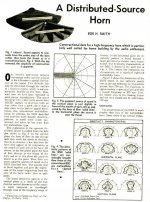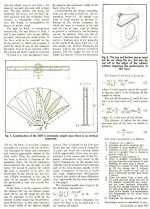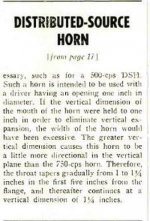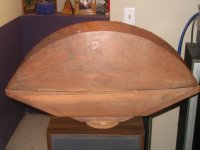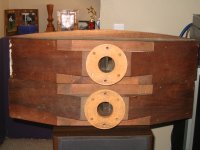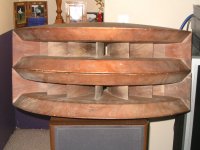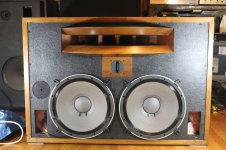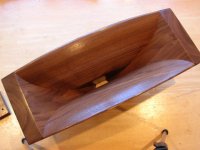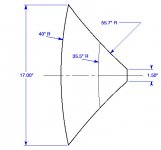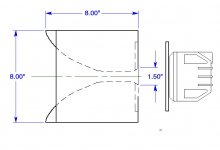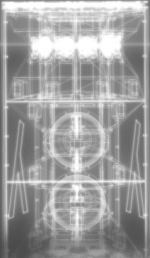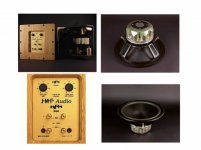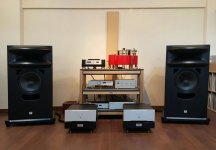Interesting!
Lately, I've been looking into multicells and sectoral horns.
The Smith horn and derivates look good on paper, but I have my doubts about combination of vanes and the diffraction mouth.
If you want to optimize the Smith horn, you will probably get something similar to Joseph Crowe's Yuichi Radials> including roundovers by mouth.
Lately, I've been looking into multicells and sectoral horns.
The Smith horn and derivates look good on paper, but I have my doubts about combination of vanes and the diffraction mouth.
If you want to optimize the Smith horn, you will probably get something similar to Joseph Crowe's Yuichi Radials> including roundovers by mouth.
Attachments
Last edited:
Rob
Do you have any idea at what frequency the modern Augspurgers are crossed over ?
Regards
Charles
Do you have any idea at what frequency the modern Augspurgers are crossed over ?
Regards
Charles
There are some good looking Smith Horns for 1" drivers on Ebay from Moldova, I bookmarked them for later, when there is some spare cash, I will definitely get a pair. The links are for reference: Horn 350 Hz 1 inches | eBay and https://www.ebay.com/i/112193907513
Could anyone experienced have a look at the dimensions if these look right? Especially the 350 Hz seems slightly small - or do the dimensions sound right? They are ~352*609*61 mm for the larger horn and 500*280*64 mm for the smaller one.
Could anyone experienced have a look at the dimensions if these look right? Especially the 350 Hz seems slightly small - or do the dimensions sound right? They are ~352*609*61 mm for the larger horn and 500*280*64 mm for the smaller one.
I had the good luck to be able to A/B a system with 15 cell horns verses one with a Smith horn. Identical drivers top and bottom. The 15 cell was my preference - because it sounded more life-like to me - but some other listeners preferred the Smith. It was much better than I expected. However for a DIY horn, the Smith is going to be waaaay easier to build. 

Augspurger horns in the later monitors are actually more akin to radial horns. In the past, Augspurger (also used) the Westlake style Smith derivatives, which came with, and without vanes (for the smaller HF horns).
Augspurgers are completely DSP-ed these days, but the old ones are presumably crossed at 800Hz or even higher, which is still quite low considering the size of the horns.
Anyway, Augspurer's old constant voltage networks are quite complicated/ingenious.
Here's an AES comment paper, in which he also touches on the angled baffles.
Augspurgers are completely DSP-ed these days, but the old ones are presumably crossed at 800Hz or even higher, which is still quite low considering the size of the horns.
Anyway, Augspurer's old constant voltage networks are quite complicated/ingenious.
Here's an AES comment paper, in which he also touches on the angled baffles.
Attachments
Last edited:
Westlake Smith horns, check the chamfered mouth:
Attachments
Last edited:
Augspurger Horn:
Attachments
-
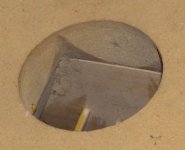 AugspurgerHornThroatCU_800 (1).JPG68.3 KB · Views: 112
AugspurgerHornThroatCU_800 (1).JPG68.3 KB · Views: 112 -
 AugspurgerHornThroat6_800.JPG73.3 KB · Views: 107
AugspurgerHornThroat6_800.JPG73.3 KB · Views: 107 -
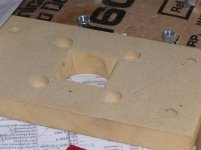 AugspurgerHornThroat5_800.JPG79.4 KB · Views: 115
AugspurgerHornThroat5_800.JPG79.4 KB · Views: 115 -
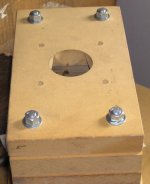 AugspurgerHornThroat4_800.JPG106.9 KB · Views: 115
AugspurgerHornThroat4_800.JPG106.9 KB · Views: 115 -
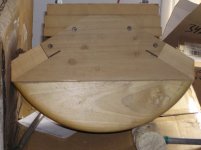 Auspurger horn top800 (1).JPG67.6 KB · Views: 119
Auspurger horn top800 (1).JPG67.6 KB · Views: 119 -
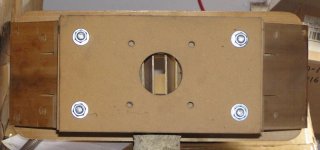 Augspurger horn back800 (1).JPG51.8 KB · Views: 143
Augspurger horn back800 (1).JPG51.8 KB · Views: 143 -
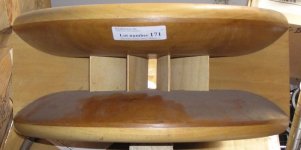 Augspurger horn front800 (1).JPG51.9 KB · Views: 160
Augspurger horn front800 (1).JPG51.9 KB · Views: 160 -
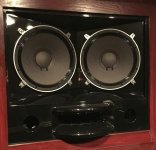 041f0ce4d7b29882a465485a50cf4f3a.jpg221.8 KB · Views: 158
041f0ce4d7b29882a465485a50cf4f3a.jpg221.8 KB · Views: 158
It would be interesting to build and test the 3 versions of termination, all else being equal.
Smith, Westlake, Augspurger.
Smith, Westlake, Augspurger.
That would be interesting indeed. Heritage forum members have built and measured Smith and 9800 horns.
The 9800 is similar to Yuichi and other radial horns, without vanes but with a pinched throat.
There's something about vanes, cells and sectors.
Pano, which multicells do you use?
The 9800 is similar to Yuichi and other radial horns, without vanes but with a pinched throat.
There's something about vanes, cells and sectors.
Pano, which multicells do you use?
Attachments
Last edited:
Lately, I've been looking into multicells and sectoral horns.
The Smith horn and derivates look good on paper, but I have my doubts about combination of vanes and the diffraction mouth.
OK, what's worse, the pioneer's sharp/truncated multi-cells, 'ricochet' fast flare sectorals or the Smith's variant?
I've already tweaked the first two as much as I know how and for high fidelity they don't come close to a large WG, though in all cases the compression driver is the weak link unless XO'd to a super tweeter.
Where to draw the line? Dr. Geddes says round oblate spheriod, so what's second best?
GM
With modern large format drivers, it's very well possible to use a bigger horn without the super tweeter. There will always be people who feel the need to add that extra sparkle on top, I am not one of them.
I guess you've also got your hands on the Altec 399s GM?
Regarding OSWGs, I am looking forward to the performance of bigger waveguides with 1.4" throats on which mabat is working.
I guess you've also got your hands on the Altec 399s GM?
Regarding OSWGs, I am looking forward to the performance of bigger waveguides with 1.4" throats on which mabat is working.
I've used Altec 203, 803, 1005 and 1505. I've also heard wooden multicells. Currently I do not have a home system with horns.Pano, which multicells do you use?
Initially I thought this (high section) is a contemporary variant of a sectoral horn:
An externally hosted image should be here but it was not working when we last tested it.
Last edited:
Where to draw the line? Dr. Geddes says round oblate spheriod, so what's second best?
You can discuss that one till the cows come home. I have never heard one of Earls systems only tweeters using that profile waveguide and they sound darn good and integrate well with the other drivers. I am partial to the Array Horns, PT waveguides and M2 waveguides but that's just my opinion as I have nothing to back it up as far as any real measured difference's. Figure you are going to EQ them to your preference any old way.
Rob 🙂
This one wasn't mentioned before, I think.
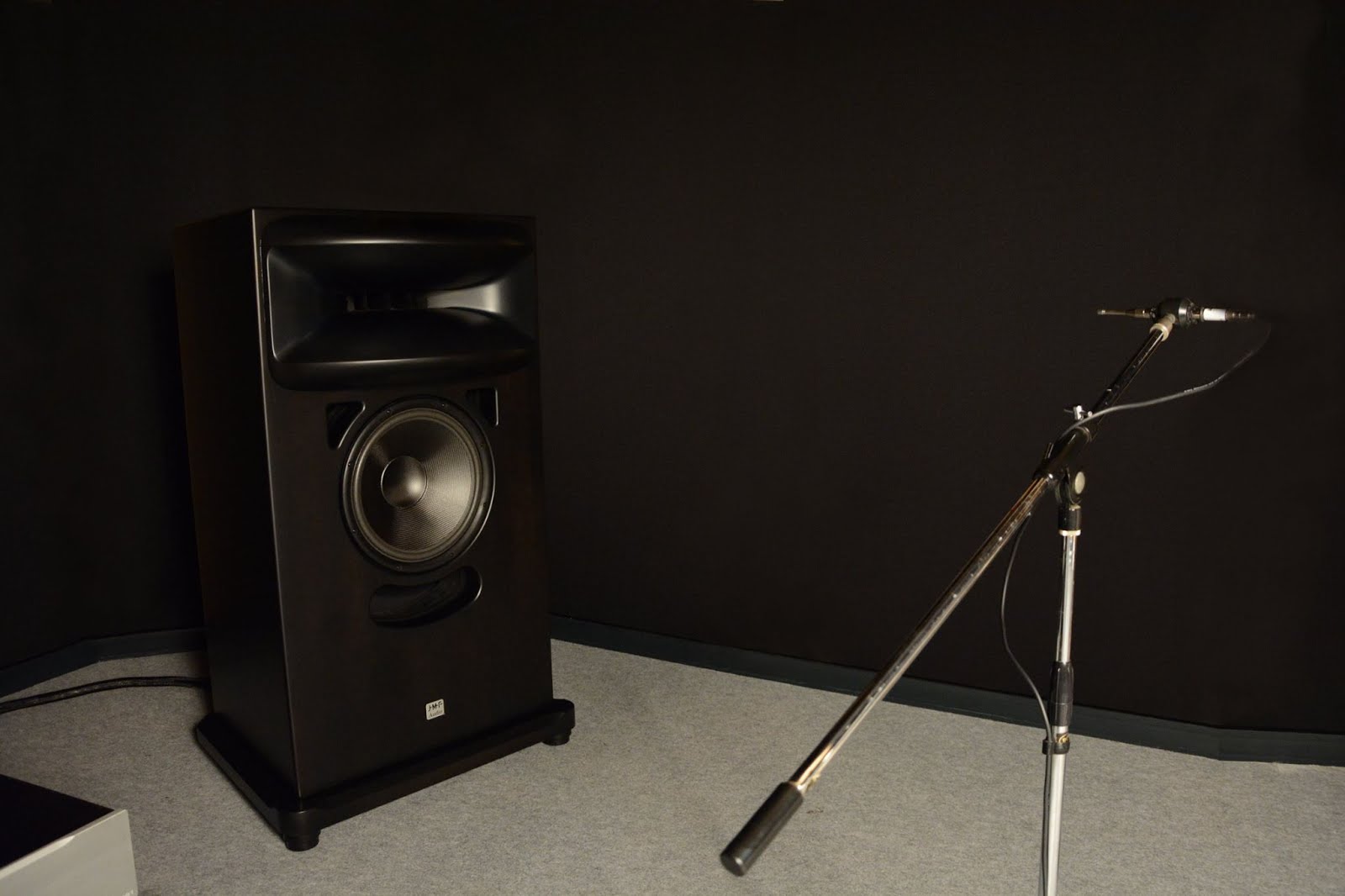
Another classic 2-way that's supposed to meet the criteria of the thread title.
It's a heavyweight, 238kg each!
The horn is about the same size as Joseph Crowe's upcoming ES-300, 70cm width and cut off is 300Hz.
Woofer is an OEM 16" with Carbon Fiber Cone and massive Neo Magnet.
Mms: 70g
Fs: 19Hz
Magnetic Flux: 416000Mx
Comp. driver: TAD TD4001
Bandwidth: 30Hz (-3dB) - 20kHz (0dB)


Another classic 2-way that's supposed to meet the criteria of the thread title.
It's a heavyweight, 238kg each!
The horn is about the same size as Joseph Crowe's upcoming ES-300, 70cm width and cut off is 300Hz.
Woofer is an OEM 16" with Carbon Fiber Cone and massive Neo Magnet.
Mms: 70g
Fs: 19Hz
Magnetic Flux: 416000Mx
Comp. driver: TAD TD4001
Bandwidth: 30Hz (-3dB) - 20kHz (0dB)
Attachments
Last edited:
Two things I have not seen discussed thoroughly;
I've seen it commented about the high end quality of a large horn....since when did horn size impede on sound quality of the treble? Sound quality being that which is pertaining to signal reproduction and not pertaining to how wide of dispersion pattern.
Second, why would a large horn beam any more than a small horn of the same design, say large jmlc vs small jmlc...of course the pattern would contain more frequencies within the directive spectrum of the horn but the beaming of the treble....why wouldn't that be identical...this aspect is governed by the exit size, is it not? If both horns have a 1.5" exit then the beaming should be identical as well, if not.....why not.
Someone else with more knowledge than me I'm sure could answer your question better, but since no one is trying I'll chime in. We discussed this many pages ago sort of, but the way I understand it, the angle of the horn walls at the frequency in question is the issue. A Tractrix has fairly parallel walls at the throat (where high frequencies launch so to speak) so it has narrow directivity at those high frequencies. A constant directivity horn like an oblate spheroidal is wider angle right from the throat so wider directivity there. A larger Tractrix horn profile will have to stay narrower longer in order to keep the profile right if that makes sense. An OS waveguide would suffer less . Just look at a large Tractrix, that throat is so long. Even at the point where it's 3" in diameter the walls are fairly parallel, yielding narrow dispersion at the wavelengths loaded at 3" area. In a smaller Tractrix at 3" diameter the walls may be flared significantly. Think about it like a garden hose spray nozzle, with small wavelengths squirting from the throat and lower frequencies squirting from the mouth. wavelength launched from a given spot of the horn correlates with the horns area at that point.
I understand this is an idiots guide and it would be an honor to have someone explain to me too exactly what's wrong with my analogy.
- Home
- Loudspeakers
- Multi-Way
- Is it possible to cover the whole spectrum, high SPL, low distortion with a 2-way?
